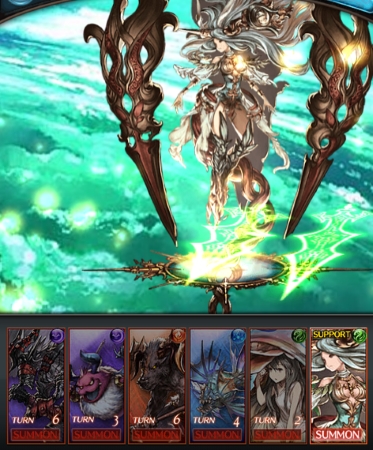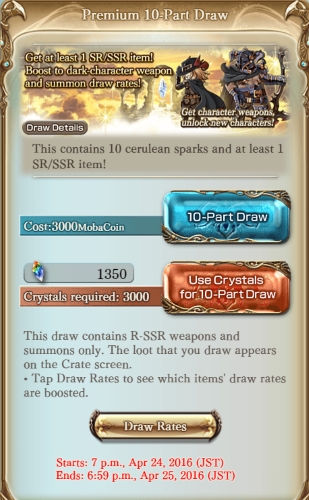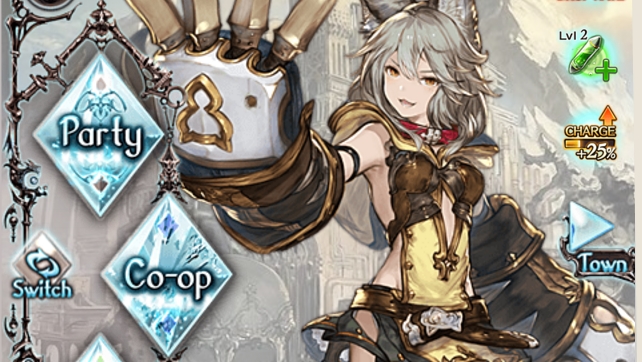I’m never sure how to feel when I see yet another new Japanese mobile game with a slew of well-known talent at the helm.
On one hand, it feels like a fall from grace that these amazing creators who were once so well-known in console RPG gaming have ended up working on mobile games. But clasped in the other hand is the acceptance that the Japanese RPG industry has moved to mobile, and that these games aren’t necessarily bad or not worth it because they’re on what most hardcore gamers consider the most casual of platforms.
Granblue Fantasy is one of many RPGs to hit the Japanese mobile market in the past few years to pique the interest of international JRPG fans but has been kept in its native region. When the Mana, SaGa, Valkyrie, and other reputable series are getting new Japan-only mobile titles, it really makes non-Japanese RPG gamers tilt their heads. Mobile is for casuals, right?
I’m not going to answer that question. What matters here is that all these series have migrated to mobile, for better or for worse, and in time mobile platforms will be the sole go-to for classic-style Japanese RPGs. The genre was never known for its big budgets. In today’s industry with budgets high enough to feed an entire country, there’s no way for these developers to continue to compete on the console market.
Granblue Fantasy is one of many mobile RPGs that are the modern equivalent of the RPGs seen on the Super Nintendo and PlayStation in the ’90s. The aesthetic charm, over-arching story featuring elemental Primals (a common theme), focus on character relationships, and class and party system all call back to a more simple and adventurous time in RPG gaming when developers were always trying something different to stand out. And Granblue Fantasy definitely stands out.
Touching on combat
The battle system here is much akin to classic turn-based RPGs. At the start it seems a simple affair, but in time ramps up to a real strategic (and grinding) challenge to become gratifying.
Your party pushes through an area fighting monsters and picking up items automatically at the start of most areas, after which you shift into a more traditional turn-based battle system.

Instead of the traditional mana system to limit skill usage is instead skill cooldowns, which is typical of mobile RPGs. Skills take a specified amount of turns once used to be usable again, meaning you have to carefully decide when to use them.
The main focus, as with most other mobile RPGs, is the combat. Progressing the story is fun (as they should be) but the real meat lies in the actual gameplay and progressing your main and sub characters to form your ideal party.
Job class system
The combination of Granblue‘s party system and turn-based combat are what make this beauty so much like the RPGs of yore. The turn-based combat is nice, but everything starts to come together when you start picking up characters you actually like and working toward more advanced jobs for your main character.
Final Fantasy Tactics fans (and fans of games with similar class systems) will find the game’s main character job system familiar but daunting.
Jobs are unlocked via reaching specified levels in other jobs. For example the Raider class requires you reach maximum level (level 20) as both a Fighter and a Thief.

Further still, you need to reach maximum levels in the Raider and Archer classes to unlock a class in the next tier, Sidewinder.

Each of the 30+ classes has its own strengths. Not only that, but you can mix and match class subskills based on what you have unlocked so far. Not to mention the use of Extended Masteries to further customize your main character.
While this all sounds complicated and confusing (it is), over time you learn to deal with these customization options as a whole. You don’t have to go for what’s considered overpowered, in fact it’s best to build your character based on your party’s needs first. It only takes a few months to reach max level in every class. It’ll feel like no time before you learn the ins and outs of Granblue Fantasy‘s job class system and it will be great.
Subcharacters and story
What would you say if I told you this game’s story and subcharacters were interesting and ultimately felt worth pushing forward over?
I’m not fond of stories in my mobile games–the only other one I play on a regular basis is Puzzle & Dragons, and for all I can tell the story is “moving orbs well makes things die”.
Somehow I found myself reading the dialogue in Granblue Fantasy.
At first I’d skip dialogue scenes, which conveniently give you a summary of what’s happened. That was my first tip off that just maybe I should pay attention. The next day I found myself reading it all. And the next day. And the next day.

It’s odd to think that the story in this type of game would be interesting. I’ve played Terra Battle, the absolutely talent-heavy game from ex-Final Fantasy dev-packed Mistwalker, and that didn’t really go the story-heavy route. Granblue Fantasy does.
It’s very hard not to want to read what’s going on once the story starts to ramp up, especially because the game goes to such lengths to make you care about the characters. Storyline characters are lively and relatable, but that’s not all: Subcharacters have their own substories for you to play through. This goes a long way to connecting the player with these characters, which in most other mobile RPGs are simply lifeless units.
It also helps that basically everything in the game is voiced. Not only that, but voiced by some of the most well-known voice talent in the Japanese gaming and anime industries. It’s very difficult not to enjoy growing subcharacters and then using your favorites to make parties. Especially coveted SSR-ranking characters.
Aethetics
For a mobile game, Granblue Fantasy is pretty gorgeous.
On the audio side of things we have half the game’s score being composed by legendary gaming composer Nobuo Uematsu and the flexible Tsutomu Narita, a more recent go-to composer for Square Enix.
Between Uematsu and Narita the game’s soundtrack is a varied delight.
Your battle, boss, and menu themes swim between the two composers, Uematsu’s work being more along the lines of traditional Final Fantasy tracks and the latter’s veering more on the side of traditional Mana tracks and even Final Fantasy Crystal Chronicles-style music.

Graphically the game isn’t rocking anyone’s world but the character, monster, and world are all all top-notch and befitting artist Hideo Minaba. Minaba is most famous for his artwork with Final Fantasy Tactics but he also graced Final Fantasy XII, Bravely Default and its sequel, any several other games with his work.
The combination of sound and visuals is what initially gives you the impression this isn’t your average mobile RPG. You delve in and see the class system, scratch your head, and wonder, “Is it really 2016?” Then you bite the bullet and start reading dialogue. That’s it. You’re finished. This game’s got you. I’m sorry.
Nothing’s perfect
There are two downsides to Granblue Fantasy that are very much worth noting:
First, the game has no actual official English release. The Japanese version has an English option, supposedly to allow overseas players to continue using their data on the Japanese servers. This means you either have to jump through some hoops to play on your mobile device or play it using Chrome on your PC, which has longer load times than on actual mobile devices. I wrote a little guide to getting in on it using any method.

Second, the game’s character-pulling RNG is not good and the game expects you to eventually spend some money. You certainly do not need a full party of top-tier characters to do reasonably in Granblue Fantasy but they do help and, honestly, who doesn’t like to feel powerful?
The chances of you getting an SR or SSR (yeah, have fun with that) are very very low and you don’t get a ton of free pulls either. This all is something you have to accept and either suck up, reroll repeatedly to avoid, or whip your wallet out to deal with.
What Granblue Fantasy does is makes you feel like you’re on your own personal adventure. You have your main character you build up with jobs, you level up and bond with your subcharacters, you progress the story bit by bit so that every day you unravel a little more of what’s going on. And the music and art go a long way to making it all feel like home.
Japanese RPG fans don’t have a ton of options to turn to these days in terms of localized titles, especially those who prefer the turn-based battle systems of the old days. Granblue Fantasy does nothing but reinforce the fact that this older style of gaming is still being made, is still in demand, and can still be done well. If we have to suck up free to play monetization systems to get it, then so be it.
A good game is a good game, whether you pay $60 once or $60 in small increments over several months, and Granblue Fantasy is a good game. No matter how much I want to fight the genre’s migration to being F2P and on mobile, I can’t deny this is a solid and compelling RPG worth playing for most fans of the genre even with its mobile-isms.







Published: Apr 24, 2016 10:12 am